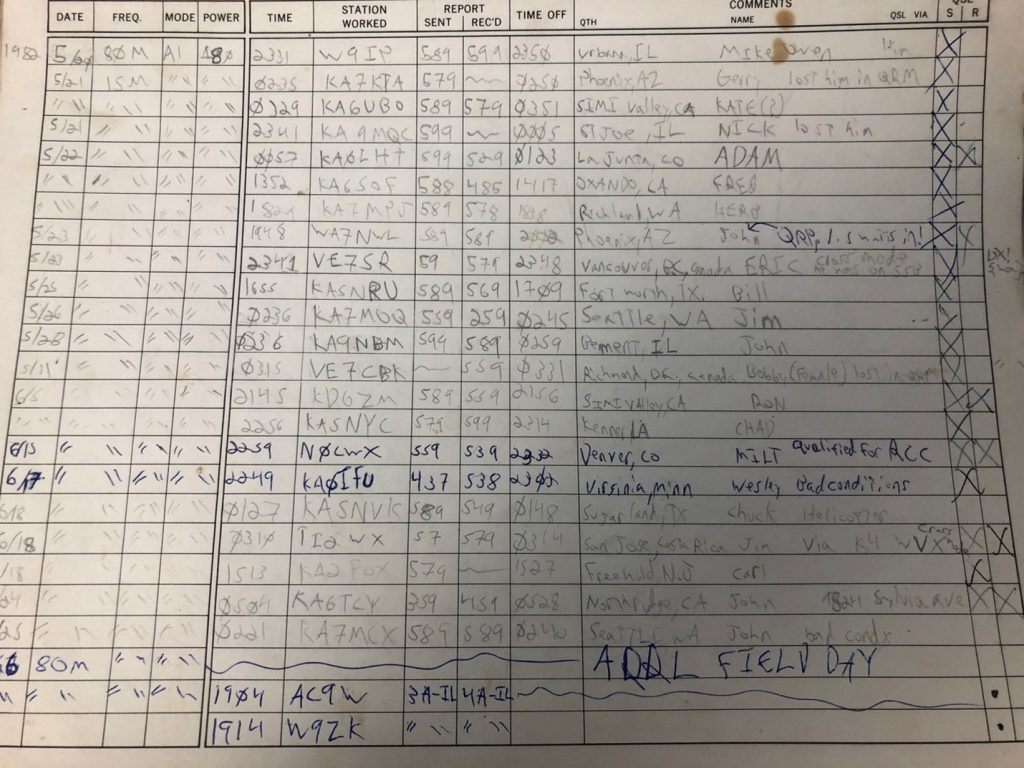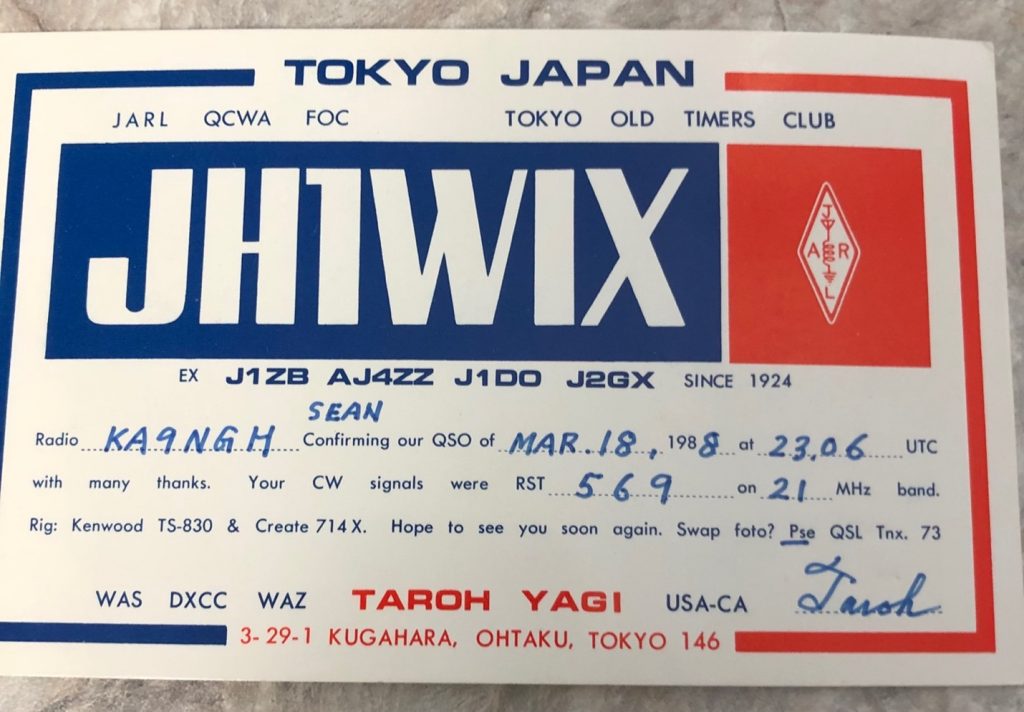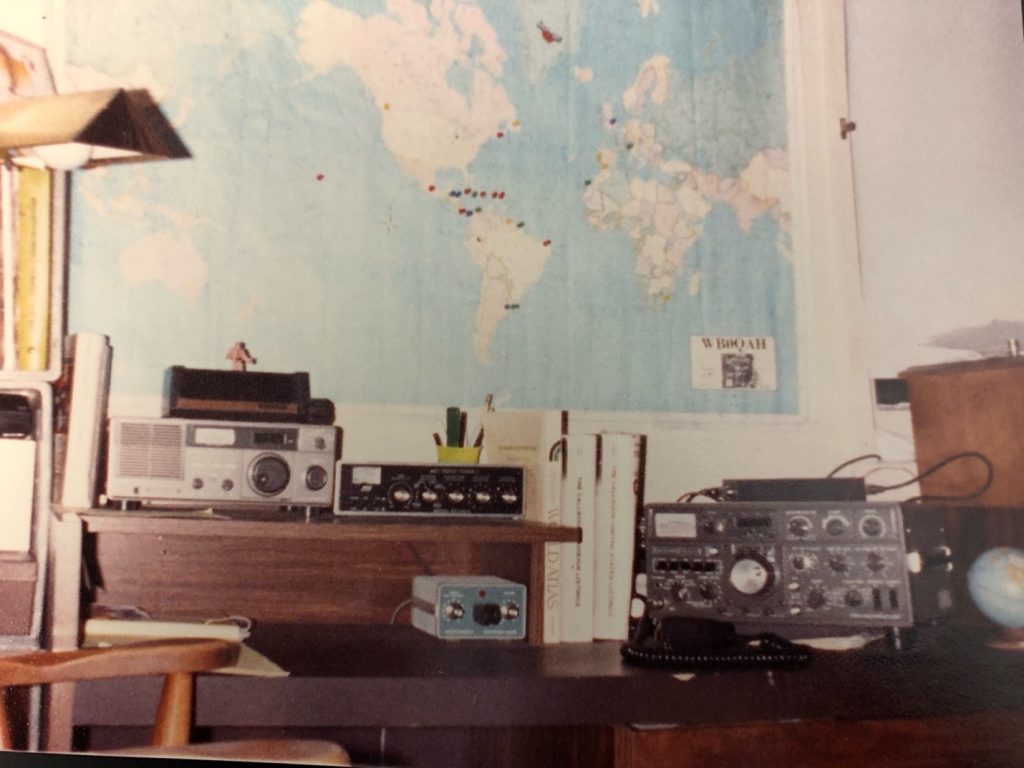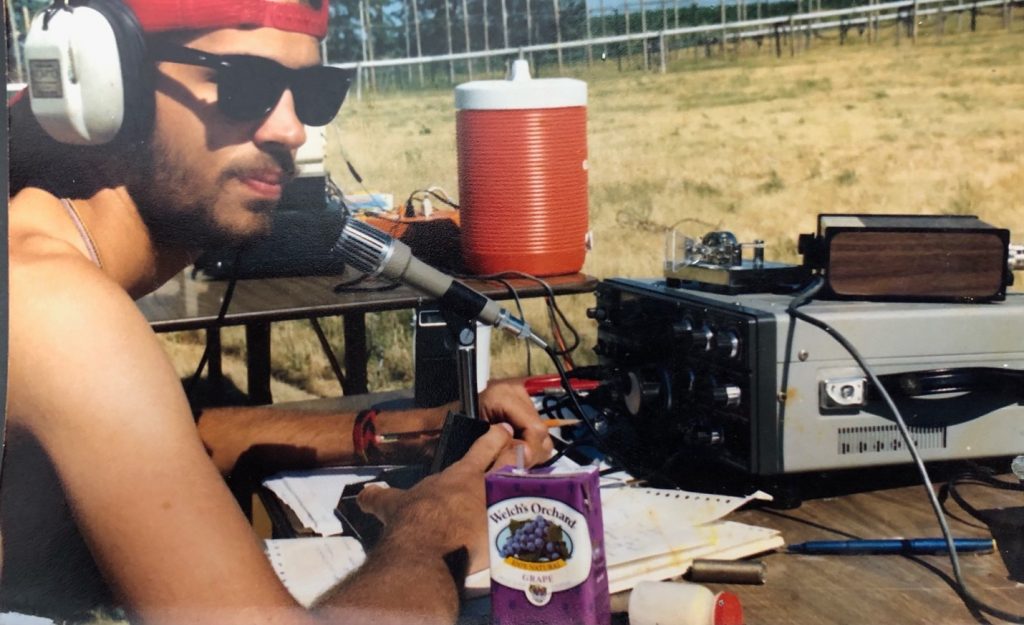Radio bit me at a very early age, and it bit hard. At home in Urbana, Illinois, I was doing broadcast band DXing when I was four and had my first shortwave radio at age five. By the age of eight, I had my first piece of “real” gear, a beat-up Hallicrafters SX-110 receiver given to me by one of my older brother’s friends who was into CB. I spent hundreds of hours in front of that radio with a pair of headphones on my head, listening intently, with loops of wire wrapped around my bedroom walls for an antenna. It was all I wanted to do.
I spent my hours in school at the library, reading up on electronics and studying world geography. At some point in these pre-Internet days, I discovered the magic spot in the Dewey Decimal System: 621.384. That’s where all the ham radio books were located. It was a revelation that not only could I listen to stations around the world, I could also get licensed and actually TALK to other individuals around the world! I wanted in on this. But as I learned more, I realized that I had to learn Morse code to earn a license, and I’d have to drive to an FCC field office to take a test. We were poor and had little money for such excursions, and Morse code intimidated me as an eight-year-old. I decided I would be happy with listening to the world and talking locally with people on a CB.
Try as I might, I just couldn’t get into CB. I enjoyed talking to people, but talking only to other people in my town while listening to stations around the globe was a huge disappointment. After some time, I resolved to get my ham radio license.
Around this time, I learned that the University of Illinois had a ham radio club connected with the Engineering Department, the Synton Amateur Radio Club, W9YH. My mother worked at the university as a typist and editor, and clubs and many extracurricular activities were open to staff and their family members. A couple of phone calls later and I was knocking on the door of the club. To me, it was a grand palace. The former site of the university radio station, it was a run-down two-story brick building with twin 150-foot towers, and tons of older gear like a Collins S-line, an R-390A receiver, and a Drake C-line. An entire library of QST, CQ and 73 magazines filled bookshelves on the second floor. Best of all, THEY HAD THEIR OWN COKE MACHINE!
To say I was welcomed into the club would not be an entirely truthful statement. Many of the members were not thrilled to have a 12-year-old kid who reminded them of their pesky little brother in their domain. I started spending every possible moment there, quickly earning the nickname Minnie The Moocher, as I constantly hit up club members for quarters to get a Coke. However, there were a couple of members who were genuinely helpful and encouraged me. My first true Elmer was Tom Ask, AC9L, who actively got me studying for the Novice test. Steve Heidorn, W9PK, gave me my first lesson in zero-beating a station. Famed contester Fred Kleber, K9VV, let me operate the club’s Drake twins on 40 meters and was the control operator for my very first contact, Floyd Myers, WB0QAH in Ottumwa, Iowa. I was nervous and stuttered. Floyd was patient and encouraging. He even sent me a QSL card, which I’ve managed to lose somewhere along the way. After that contact, I was bound and determined to get that license. Tom Ask sold me his old Heathkit HW-101. I threw a 40 meter dipole in a tree, bought myself a straight key from Radio Shack, and bolted it to a board. I was on my way.
After a few months of study, a blind law student affiliated with W9YH met me in the Electrical Engineering building on campus and gave me my 5 words-per-minute code test. I passed, and also passed the written portion shortly thereafter. For me, the code test was easier than the written exam! After several weeks, I received my license in the mail on May 20, 1982: I was KA9NGH. I was 14 years old.
Once I had my license, I was nervous to actually use it! After several minutes of wondering what to do, I phoned Synton member Mike Owen, W9IP, a big moonbounce afficionado. He went down to the club and worked me on 80 meter CW in the Novice sub-band for my first contact. I’m sure my CW was sloppy, but I’d made my first contact.
I spent the next week afraid to use CW but desperate to get on the air. I finally reconciled myself to the fact that if I wanted to be on the air, it was going to be on CW. From then on, I started taking my code very seriously and wanted to do better. I was on the 15 meter Novice band every day and worked anything I could muster.
Field Day came just a month after I was licensed. The W9YH crew had secured an operating site at a university fire tower outside of town. It had an enclosed 10 x 10 room about 90 feet above the prairie. They asked me if I would be their Novice station and I quickly agreed. I carried my gear up those stairs and threw a sloper off the observation platform atop the tower. It was loose and fun, and incredibly exciting. Everything was new to me and I just dove in as best I could. It was hot, there were wild antics by the college crew, and we ate cold KFC chicken by the bucketful. At one point I was asked to help some of the students with their effort to make a satellite contact. I got to be the human rotor, holding the antenna and trying to aim it properly. The result was a comedy of errors – “No, NO, point it THAT WAY!”–I don’t think we actually made contact with anybody. I slept on the observation tower that night, 100 feet above the Illinois prairie, loving every minute of the experience. It felt like I worked 500 stations that weekend; my logbook shows only 47.
I spent the last half of 1982 primarily on 15 and 40 meters. Working DX on 15 meters was interesting; the Novice CW sub-band corresponded with the lower portion of the phone band for many other countries, and some DX stations would take the time to listen for U.S. Novices on slow CW while transmitting on USB. The first DX I worked under these circumstances was TI2WX. He had a good pileup of Novices calling him, and he was working them as quickly as he could. After some effort, he heard me! I slowly sent “U R my 1st DX QSO.” He replied, “Don’t get too excited, kid… Costa Rica isn’t a big deal! 73, QRZ?” I didn’t care if he felt Costa Rica was not a big deal… it was a big deal to me! My first DX.
It was the first of many that fall: Brazil, New Zealand, South Africa, and Japan. I was hooked on seeing what new country I could make a contact with, and spent the winter of 1982-1983 on 15 meter CW, trying to work as much DX as I could.

Gradually, I shifted over to 40 meters, where I spent every afternoon and evening after school developing my CW skills with other newbies in the Novice sub-band. Every now and then, a kind General or Extra would come into the Novice bands and work us. Back then, there was a week-long event for newbies called the Novice Roundup, which allowed Novices and Technicians several hours of operating time over the course of a week to make as many contacts as possible. I worked W1AW and former ARRL CEO Dave Sumner, K1ZZ, in my first Novice Roundup, which was a great treat.

“Taroh Yagi, JH1WIX, spent a lot of time working U.S. Novices in the Novice sub-bands. He was the first contact with Japan for many, many U.S. hams. A fine gentleman. I worked him in March 1988 and still have his treasured QSL card.”
Sadly, my growth in amateur radio was interrupted right after I graduated from high school. My mom and I moved into a small apartment for a time, and I had no hope of putting up an antenna. I was off the air for almost three years, relegated back to only shortwave listening. Two events changed this. We moved into a small house on Michigan Avenue in Urbana in May 1987, around the time that the FCC granted Novices and Technicians SSB privileges on 10 meters. I dusted off my Kenwood 820, built a dipole out of speaker wire, and put it in the attic of our new house.
On June 8, 1987, I made my first 10 meter SSB contact with Dave, N4JGQ in Vienna, Virginia. I made 18 contacts that night, and discovered the joys of sporadic-E propagation. That was all I needed to get involved again, with gusto. Night after night after getting home from work, I’d work sporadic-E openings on 10 meters. They would start off to the East Coast, work down to the Southeast and to the Gulf states, suddenly pop open to Colorado and New Mexico, and work their way toward the Pacific Northwest before fading for the evening. I did this all summer long, and didn’t make a contact on another band until January 1988. I worked my first European, CU2CE, in the Azores on October 11.

10 meters rejuvenated my interest in ham radio. Great contacts with other hams worldwide got me hooked. Soon I had a small tower with a four-element 10 meter Yagi. Unbeknownst to me, we were just about to hit the biggest solar cycle peak in decades: 1989-1990. By the time I upgraded to General in 1989 and got my new call, N9HXG, I’d already worked almost 100 countries on 10 meters. It was the perfect time to get access to all of the HF bands, and I spent every waking moment I could on the radio, working DXCC entities I’d never even heard of before. The spine on my Rand McNally atlas gave out from constantly looking up unknown chunks of rock, usually in the South Pacific.
Every ham radio operator has stories from their entry into the hobby. I’d spent my childhood listening for signals as far away as I could imagine; by 1988, I was a full-blown contester and DXer, on the air as much as possible. It has been a constant in my life ever since, and I’ve always found new things to pursue in radio like VHF/UHF operating, backpack QRP from atop mountain summits or state parks, and satellite communications. It even ultimately led to me working at the ARRL for ten years, where I developed the National Parks on the Air (NPOTA) program in 2016.

My station may be smaller than it has been in years past, but I still find cool stuff to pursue. I spend my time trying to contact all 488 grid squares in the 48 contiguous Unites States via satellite, transmit via satellite from as many grid squares as possible, and use my modest dipole to try and work all 47 Japanese prefectures (kind of like a U.S. state) via FT8. I’m frequently tired, but never bored.
I can’t imagine what my life would have been like without ham radio.

